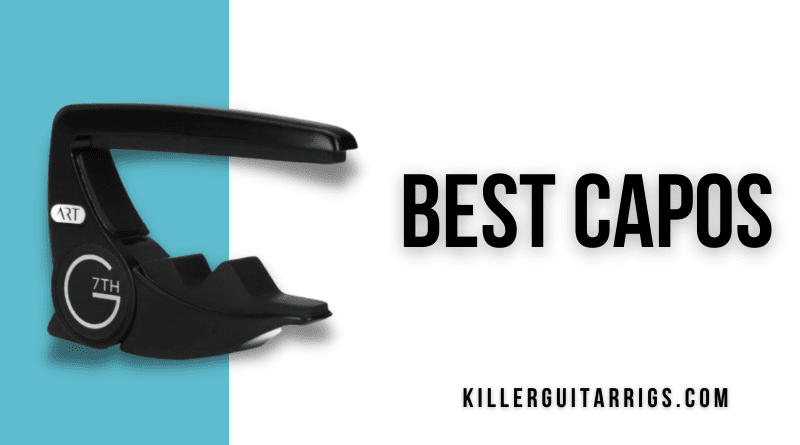Capos are almost as old as the guitar itself and today’s best guitar capos still do the same job as those early models. These devices have been helping guitarists to change key without having to relearn their instrument for almost 300 years.
Today’s capo has come a long way since the original models, with multiple styles in use and various technologies employed to get the perfect tone. In this KillerGuitarRigs Review, we’ll be looking at the 5 best capos on the market.
In our reviews we looked for ease of use, tuning stability and fret buzz, and whether or not the unit would be likely to cause damage to a guitar’s finish. To make the reviews even more thorough, we tested them on 3 different guitars, a Fender Stratocaster with a slim asymmetrical neck, an Epiphone Les Paul Jr. with its enormous ’59 profile neck, and a Martin 000-15M acoustic, which has something of a mid-size neck profile.
Keep reading as we learn more about these capos!
Read more about our review process.
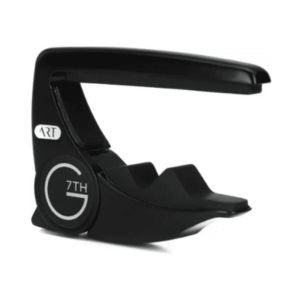
G7th Performance 3 Steel String Capo
Features: Adaptive radius technology, Silicon padding, Zinc alloy construction
Benefits: Works with any fretboard radius, Slides easily up and down the neck, Reduces fret buzz
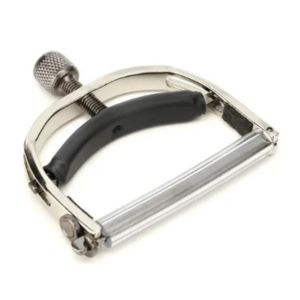
Paige 6-string Standard Acoustic Guitar Capo
Features: Direct center tension, Metal construction, Screw adjustment
Benefits: One handed operation, Buzz free, Easily stored behind the nut
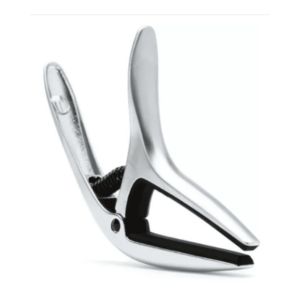
Ernie Ball Axis Capo
Features: Dual radius design, Aluminum construction, Rubber padding
Benefits: Easy to adjust, Doesn't weigh down the neck, Works on extended range guitars
Contents
Our Top 3
Our Top Pick was the Paige 6 String Standard Capo. It offers excellent performance and gives the user complete control over how much tension is applied. It’s exceptionally made and feels robust enough to withstand heavy use, even by working musicians.
Those looking to get a great capo without spending too much should take a look at our Best Budget pick, the Ernie Ball Axis Capo. It’s a basic model, but it does everything the average guitarist would ever need it to. It’s reliable and best of all, cheap!
If money isn’t a concern and you’re looking for the best capo on the market, check out our Editor’s Choice the G7th Performance 3 Steel String Capo. Using proprietary technology, it offers unparalleled performance when it comes to even tension and tuning stability.
Individual Reviews

Paige 6 String Standard Guitar Capo
An easy to adjust yoke style capo.
This capo provides a great blend of performance and price. The yoke design ensures even pressure across the fretboard, and the soft felt padding is safe for all finishes, including delicate vintage nitro lacquers.
The Paige 6-String Standard Guitar Capo was a big hit during testing, it performed well, and we were impressed with the overall quality.
Our first test was to establish how easy it was to get set up. To mount it, we first had to unlatch the bar. Then we were able to fit it around the neck before re-securing the latch. It may not seem as convenient as a spring-loaded type, but we found it to be incredibly secure once on. That in and of itself is a standout feature.
We found that the knurled grip on the tension adjustment screw was sturdy and easy to manipulate, even with sweaty hands. As advertised, it was capable of one-handed adjustment, which is an absolute must, especially for gigging musicians.
The yoke design offered even application of tension across the strings. We didn’t experience noticeable fret buzz when playing, nor did we find that tuning issues were unmanageable.
Despite being billed as an acoustic capo, we found it worked well on the Les Paul and Strat as well as our Martin. While it’s always a good idea to purchase accessories designed specifically for your guitar, sometimes even type-specific products like this will work almost universally.
After using this capo, we inspected our guitars’ necks and found no damage or scratches whatsoever. Which is, of course, what we expect from every capo. The padding was felt, rather than usual rubber, which makes it safe for all finishes, including nitrocellulose.
Verdict: We really liked the Paige 6 String Standard Guitar Capo. It’s the only yoke-style model on this list, which made it stand out right away. It applied good, even pressure across the entire fretboard on a range of radii, and we were easily able to adjust it during use. The build quality was good and we have no doubt it would hold up to years of heavy use.
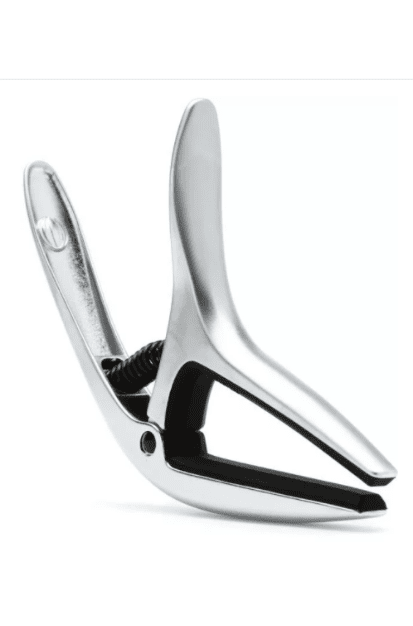
Ernie Ball Axis Capo
A basic capo for players of all abilities.
Simplicity defined, this capo is a standard spring loaded model that’s incredibly easy to use, looks great, and offers solid performance at an impossible to beat price point.
After spending some time with the Ernie Ball Axis, we found ourselves truly impressed, despite the fact that it was the cheapest model on test by quite a margin.
After unboxing, we set about finding out how easy this capo was to set up and adjust. Being a simple spring-action capo, it was simply a case of squeezing the two legs together against the tension of the spring, placing it over the neck, and letting it go.
Once it was on the neck, we were easily able to adjust it with one hand by giving it a gentle squeeze and sliding it up or down.
The overall design was super slick. There were no sharp angles or corners and the matte silver finish looked premium. There was very little lateral play or wobble between the 2 parts of the arm, which bodes well for the longevity of this capo.
One of the neatest things about the design is that it works with stringed instruments of pretty much all sizes, from ukuleles to 7-string guitars. We had no issues getting it on any of the 3 guitars we used for the test.
The rubber pads covered the entire length of both legs on the Axis capo. This made it completely reversible, giving us the option of a flat pad for larger radii or a more curved pad for guitars with a smaller radius on their fretboards. We found this versatility gave us great contact across all the strings on all 3 test guitars. We didn’t experience fret buzz and we didn’t experience any significant problems with tuning stability while using this capo.
Verdict: We found that the Ernie Ball Axis Capo far outperformed its price tag, offering easy setup and adjustment without any noticeable loss of tonal performance while using it. It looks great and because it works on a huge range of neck sizes, there’s no need to own multiple capos if you keep one of these in your gig bag.
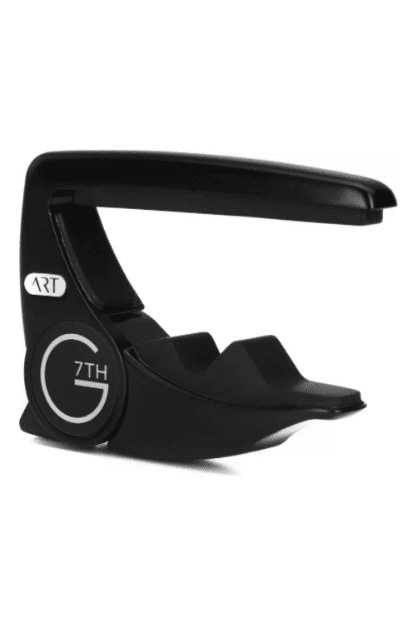
G7th Performance 3 Steel String Guitar Capo
An outstanding capo with technology at its core.
With this capo you’re getting a high performing accessory that actually meets its claims. It offers the best tuning stability of any capo on the market, while protecting your guitar’s finish and remaining easy to use.
The G7th Performance 3 Steel String Capo is at the pinnacle of capo technology. Loss of tuning stability is one of the biggest issues plaguing standard capos, but this high-tech model seems to have solved that problem.
The mechanism doesn’t rely on a spring or a screw-down clamp. Instead, all we needed to do was place it into position and squeeze it. To adjust, we pressed the release button and it loosened enough to move to whichever position we needed it to be in.
With this capo, the real attraction was the Adaptive Radius Technology, or ART for short. Within the body of the capo is a series of cams that adjust to the radius of the fretboard it’s placed on in real time, with no manual adjustment necessary. The result was absolutely staggering. With a good capo, you shouldn’t really notice any loss of tuning, but it can happen. With this G7th capo, tuning was genuinely perfect every time we clamped it down.
Not only was tuning perfect, but there was no fret buzz, something that is typically caused by insufficient pressure on the strings.
We found that it worked well on all three guitars, proving that it could handle multiple string gauges, as well as varying neck sizes.
Another notable feature of the G7th model was that the pads are harder than the typical rubber you’d find on a capo. This is to reduce the dampening effect of soft rubber that often causes capos to drain the tone from a guitar. We can happily report that the hard padding worked extremely well, and produced, in our opinion, the closest to capo-free tone we’ve heard from any model. Despite the hard rubber, we found no damage to the fretboard or the neck after use.
Verdict: Capos are often an overlooked accessory when it comes to research and development, so it’s nice to see that the makers of the G7th Performance 3 Steel String Capo asked themselves what could be done to make the humble capo better. It’s simple to use, results in great tone, and although it’s quite pricey for a capo, in our opinion it’s worth every penny.

D’Addario NS Artist Capo
A versatile capo with easy tension adjustment.
This capo is feature packed, with adjustable spring tension and even a pick holder. It’s lightweight, and offers easy and rapid adjustability with just one hand.
The D’Addario NS Artist Capo comes from a brand with a long-standing heritage of making excellent guitar accessories, and this capo absolutely lives up to the legacy.
It is a trigger-style capo that we found as easy to get set up as any other model in this style. All we needed to do was squeeze the legs together and place it over the neck.
As briefly mentioned, it did feature adjustable tension which is a great concept – rather than just relying on one size fits all spring tension, we were able to create relief by making it slacker, preventing tuning issues, or make it tighter to reduce fret buzz. We were pleased with the results. When it was set up properly, we found that the guitars stayed in tune and there was zero fret buzz.
One issue we found with the adjustable tension was that it still needed to be adjusted if we moved it to different neck positions. For example, when we had it set up perfectly for the 2nd fret, due to the change in taper of the guitar’s neck as we went further up the fretboard. This was particularly obvious on the Strat with its asymmetrical neck, and on the Martin.
Being aluminum, we found it to be extremely lightweight, which is always nice in a capo, as heavy models can really throw off the balance of the instrument.
Finally, after inspecting the guitars post-use, we found no signs of any damage to the finish.
Verdict: The D’Addario NS Artist Capo is a great product that works well on a range of guitars thanks to its adjustable tension. It’s better for the casual user rather than working musicians who may need to quickly switch it to other positions or other guitars, as it will likely need to be adjusted. It’s otherwise very well made and it looks great.
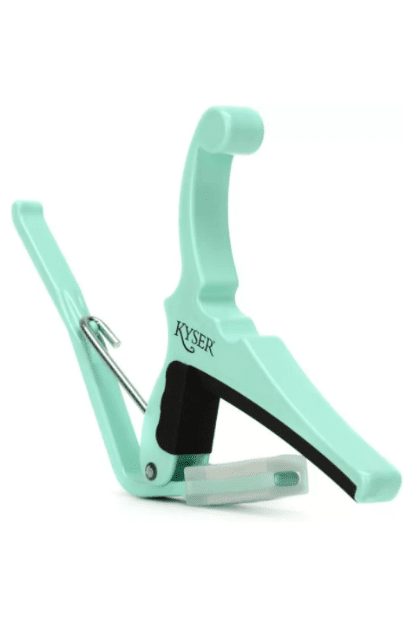
Kyser x Fender Quick Change Capo
A classic design in a range of contemporary colors.
This awesome capo is available in a wide range of cool colors, designed to exactly match a range of Fender paint finishes. It offers some of the easiest one hand adjustability of any capo on the market, and the build quality is fantastic.
Kyser capos have always been incredibly popular for their light weight and easy to use design, but Fender players in particular will enjoy the Kyser x Fender Quick Change Capo.
This is another trigger-style model and thanks to the oversize legs, grabbing it and moving it up and down the fretboard was incredibly easy. It’s a spring-loaded unit, but rather than a linear spring, it uses a torsion spring.
The issue with spring-loaded units like this is they don’t apply the same amount of tension on every size of neck. We found it to be great with the Strat, but on the Martin and the Les Paul, it pulled the strings sharp.
We had a Surf Green version, which perfectly matched the surf green finish on the Strat. While it doesn’t affect performance in the slightest, we thought it was a cool touch. It’s also available in Shell Pink, Olympic White, Daphne Blue, Butterscotch Blonde, and Black.
The foam on the fretboard side was amongst the softest of all the models we tested. While there wasn’t a vast amount of tone loss, it was still noticeable when compared back-to-back with the G7th capo.
While it didn’t happen to us during the test, we are concerned that the cover on the arm that goes on the back of the neck could slip off, resulting in damage to not just the finish, but dents in the wood. With that in mind, we found ourselves being hyperconscious of this when taking it off the guitar or making adjustments.
Verdict: The Kyser x Fender Quick Change is by all accounts a great Capo, especially for players who prefer thinner necks. While the colors are Fender specific, it doesn’t mean that these capos are only for Fender guitars. They are compatible with most makes and models, and despite having a few shortcomings, still represent great value.
How to Choose The Right Capo for You
This buyer’s guide aims to answer some of the most frequently asked questions about capos and how to use them effectively.
What Are Capos For?
Capos are devices used by guitarists to effectively shorten the length of their strings. When in use, they take the guitar’s nut out of the equation and turn the fret below where they are placed into a new temporary nut (although the nut still works to keep the alignment of the strings correct).
The reason capos are used is to allow a guitarist to change the key they want to play in without having to learn different chord structures in different positions on the fretboard. Or without having to adjust the pitch of the strings using the tuners, which understandably would have a much more limited range.
By using a capo, it’s possible to play chords in the exact same way as you would without one, and it will sound correct for the key you’re playing in. With each fret you move the capo up or down, you alter the key by half a step. They are used in practically all genres and have been used by some of the biggest names in music.
What Types of Capos Are Available?
There are a number of different styles available. Each comes with pros and cons, and ultimately personal choice will impact which you prefer.
Strap Capos
The strap capo is one of the oldest and simplest designs around. The bar that rests on the strings is secured to the guitar by way of a strap that goes around the neck and secures to the other side of the capo bar. They can be made with elastic or stiffer fabrics, and offer easy operation.
They’re popular with beginners and cost very little to buy. The main downside is they’re difficult to adjust quickly with one hand, and the fabric is susceptible to wear and tear that will eventually render it useless.
Toggle Capos
Toggle capos are similar to the strap capos in that they are simple bars with a strip of fabric, but they differ in their securing method. Rather than using press studs or buckles, toggle capos work on the principle of a toggle that slips into a notch and a lever that gets pulled over to secure it.
They also suffer with the same long-term reliability issues, in that the fabric can stretch out or snap altogether over time. And of course with notches being used, if the perfect tension for your guitar falls between 2 of the notches, you’ll either over-tighten and pull the strings sharp or you’ll be too slack and have fret buzz.
Trigger Capos
Trigger capos are some of the most popular models in use today. They use a spring-loaded arm that rests in the closed position to apply constant pressure to the strings. To slacken and adjust, a player needs to squeeze the legs at the other side to open the jaws of the capo.
They offer some of the fastest adjustment and easiest operation of any capos and last almost forever, but they offer no adjustability and sometimes have the tendency to pull the strings laterally, affecting your guitar’s intonation negatively.
Adjustable Screw Capos
Adjustable screw capos are essentially an improved trigger capo. They mostly look the same and have the same benefits, but the inclusion of an adjustment screw on the spring means they can be closely tailored to apply the perfect tension to almost any guitar neck.
The downside is that they lose some of the adjustment speed that makes the standard trigger capo so popular.
Yoke Capos
Yoke capos are so named because of their yoke-like shape. They work quite differently than other types of capo insomuch as they use a screw to apply pressure directly to the back of the neck, which provides excellent control over the capo’s tension on the strings.
Because the pressure is applied directly over the back, yoke capos solve the problem that adjustable screw capos still face in lateral tension, causing intonation issues. Their downside is that they can be difficult to adjust and maneuver up and down the neck.
Final Thoughts
Capos are truly an essential accessory for all guitarists. Whether you’re adjusting pitch to match a singer’s range or you’re trying to play along with the original recording of one of your favorite songs in its original key, a capo will help.
To summarize our favorites from this review, we found that the Paige 6 String Standard Capo offered great performance in a number of areas while remaining reasonably priced. The Ernie Ball Axis Capo was an outright bargain, and is ideal for players on a tight budget. If you’re looking for the best of the best, the G7th Performance 3 Steel String Capo is our absolute favorite.

